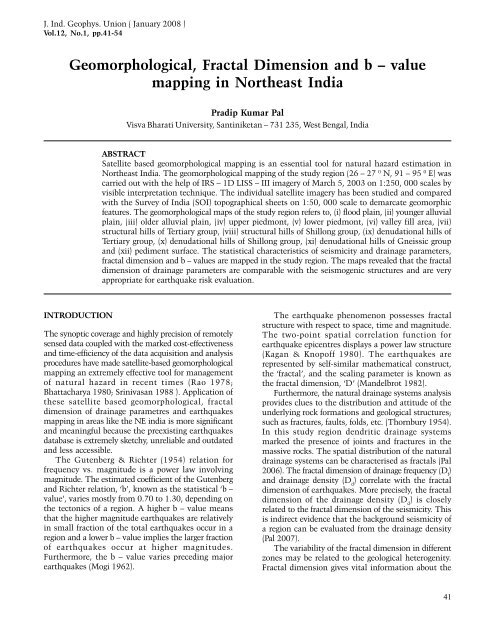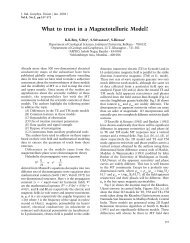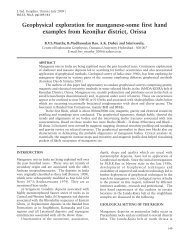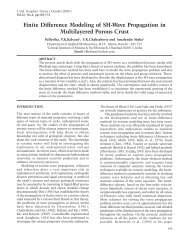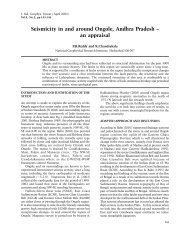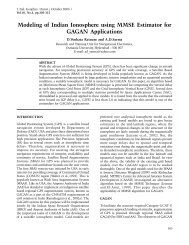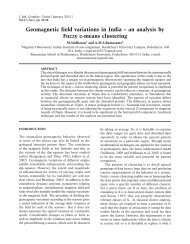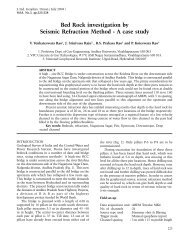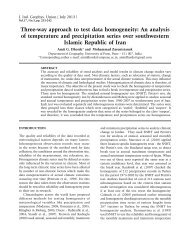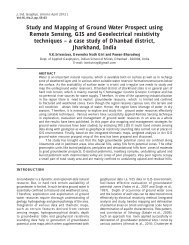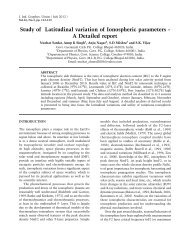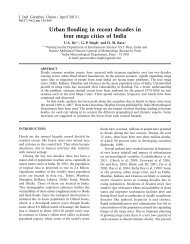Pradip Kumar Pal - IGU
Pradip Kumar Pal - IGU
Pradip Kumar Pal - IGU
You also want an ePaper? Increase the reach of your titles
YUMPU automatically turns print PDFs into web optimized ePapers that Google loves.
Figure 1D. Geomorphic features in the study region.STUDY REGIONThe present study covers from latitudes 26 0 to 27 0N and longitudes 91 0 to 95 0 E of the Northeast India.However to study the seismicity patterns, as well asto correlate with the fractal mapping of naturaldrainage systems the surrounding regions have alsobeen incoroporated. The relief of most of the hills inthe study region varies from 130 meters to 1610meters above mean sea level. Geologically, the studyarea comprises oldest to youngest rock types:Precambrian gneissic complex, the Shillong group,older and younger alluvium. The topography of thisregion reveals a criss-cross pattern of faults cuttingthe ancient rocks of the basement (Fig. 2). Theearthquakes in the Himalayan arc are referred tocollision tectonics and are associated with the knownregional thrusts, the Main Boundary Thrust (MBT)46
Figure 2. Structural features on satellite images in the study region.and the Main Central Thrust (MCT) [Ni & Barajangi,1984). The earthquakes in the study region are mostlyconfined within the depth range of 20 to 40 km (Fig.3). The earthquakes in the Shillong plateau and Assamvalley area (bounded by the MBT to the North andby the Dauki fault to the South) are reverse faultingand strike slip faulting. Microearthquake investigation,however, revealed transverse tectonics in the ArunachalHimalaya (Kayal & De 1991). To the east of Shillongplateau lies the Mikir massif, which is separated fromthe Shillong massif by NW – SE Kopili lineament andboth the Mikir hills area as well as the Shillong plateauare in equally active (Nandy 1980). The earthquakesin the Burmese arc, on the other hand, are referredto subduction tectonics; normal, thrust and strikeslipfaulting (Mukhopadhyay 1992).47
Geomorphological, Fractal Dimension and b – value mapping in Northeast IndiaFigure 7. Map showing the contours of fractal dimension (D) in the study region with 1 degree grid : (a) drainagefrequency; (b) drainage density, with respect to the statistical median value of the computed drainage frequency anddrainage density in each degree grid respectively. The epicentres for the earthquakes also shown.51
<strong>Pradip</strong> <strong>Kumar</strong> <strong>Pal</strong>Figure 8. Map showing the contours of fractal dimension (D) in the study region with 1 degree grid : (a) drainagefrequency; (b) drainage density, with respect to the maximum value of the computed drainage frequency and drainagedensity in each degree grid respectively. The epicentres for the earthquakes also shown.52
Geomorphological, Fractal Dimension and b – value mapping in Northeast IndiaCONCLUSIONSIt may me seen that while the study region as a wholeis highly seismic, there are pockets of very highseismicity with other small areas of comparatively lessactivity.Bhattacharya, Majumdar & Kayal (2002) studiedfractal dimension of this seismically active zone(latitude 24 – 28 0 N and longitude 89 – 98 0 E) usingthe teleismic ISC data ( ) and NGRI / RRL(J)data ( ) by correlation integral method with 2degree and 1 degree grided spacing. They estimated thefractal dimension value as 0.80 to 1.90 and 1.05 to1.75. Their results are comparable with the estimatedfractal dimension of earthquakes with the presentstudy in this region.Furthermore, in this present study the fractaldimension of earthquakes are comparable to the fractaldimension of drainage parametres (as it is obviousfrom the trends of the contours of the fractaldimensions of earthquakes, drainage frequency anddrainage density, spatial distribution of earthquakeepicentres and also from the b – value contours).Hence, the fractal dimension mapping of drainageparametres may be identified as the seismogenicstructures in this study region; an inhabitantstructural and lithological controlling agents oflandform evoluation of the mother earth.Keeping in view the overall urgency and low costprovided by the funding authority for this work, onlyfew numbers of the recent time of 5 th March, 2003satellite imageries (very costly) have been studied byvisible interpretation techniques. Also, the imagescover very small area. Hence, this technique utilisedfor earthquake risk evaluation from the naturaldrainage parametres may provide a broadly new idearegarding the earthquake hazard estimation.ACKNOWLEDGEMENTSThis study is a part of the research work carried outin a research project for the Young Scientists Schemeof the Science and Engineering Research Council(SERC), Department of Science & Technology,Ministry of Science and Technology, New Delhi,Government of India.REFERENCESAki, K., 1965. Maximum likelihood estimate of b in theformula log N = a - bM and its confidence limits,Bull. Earthquake Res. Inst. Univ. Tokyo, 43, 237-239.Bhattacharya, A., 1980. Geological and geomorphologicalmapping using Landsat - MSS data in Tripura area,Proc. Indian Photo Interpretation Institute, Dehradun.Bhattacharya, P.M., Majumdar, R.K. & Kayal, J.R., 2002.Fractal dimension and b – value mapping in northeastIndia, J. Curri. Sc., 82(12), 1486-1491.Grassberger, P. & Procaccia, I., 1983. Measuring thestrangeness of strange attractors, J. Physica D., 9, 189-208.Grassberger, P., 1983. Generalized dimensions of strangeattractors, Phys. Lett. A., 97, 227-230.Gutenberg, B. & Richter, C.F., 1954. Seismicity of the earthand related phenomena, Princeton University Press.Hirata, T., 1989. A correlation between the b value and thefractal dimension of earthquakes, J. Geophys. Res.,94(B6), 7507-7514.Hirata, T., 1989a. Fractal dimension of fault systems inJapan-Fractal structure in rock fracture geometry atvarious scales, J. Pure and Appl. Geophys., 131, 157-170.Kagan, Y.Y. & Knopoff, L., 1980. Spatial distribution ofearthquakes – The two-point correlation function,Geophys. J. R. Astron. Soc., 62, 303-320.Kanamori, H. & Anderson, D.L., 1975. Theoretical basesof some empirical relations in seismology, Bull. Seis.Soc. Am., 65, 1073-1095.Kayal, J.R. & De, Reena, 1991. Seismicity and tectonics inNortheast India, Bull. Seis. Soc. Am., 91, 131-138.Mandelbort, B.B., 1982. The fractal geometry of nature,W.H. Freeman, San Francisco.Mogi, K., 1985. Earthquake prediction, Academic press,Tokyo, New York and London.Mukhopadhyay, M., 1992. On earthquake focal mechanismstudies for the Burmese arc, J. Curri. Sc. Special Issue,62(1&2), 72-85.Nandy, D.R., 1980. Tectonic pattern in northeastern India,Indian J. Earth Sci., 7, 103-107.Ni. J. & Barazangi, M., 1984. Seismotectonics of theHimalayan Collision Zone – Geometry of theUnderstanding Indian plate beneath Himalaya, J.Geophys. Res., 89, 1147-1163.Ogata, Y., 1988. Statistical models for earthquakeoccurrences and residual analysis for point processes,J. Am. Stat. Assoc., 83, 401.<strong>Pal</strong>, P.K., 2006. The fractal patterns of drainage systems andseismicity to estimate the seismic hazard in Assamtectonic framework, Scientific Note, DST- SR / FTP /ESA-016 / 2002, Science and Engineering ResearchCouncil, New Delhi.<strong>Pal</strong>, P.K.,2007. Correlation between the fractal dimensionof drainage parameters and seismicity in NortheastIndia, J. Geological Society of India, 69(4), 765-772.53
Rao, D.P., 1978. Utility of Landsat coverage in small-scalegeomorphological mapping: Some example fromIndia, Photonirvachak, J. of Ind. Soc. of RemoteSensing, 6(22), 49-53.Smith, T.A., 1988. Phys. Lett. A., 133, 283-288.Srinivasan, P., 1988. Use of remote sensing techniques fordetail hydrogeomorphological investigations in partsof Narmadasagar Command Area, M.P.,Photonirvachak, J. Ind. Soc. of Remote Sensing, 16(1),55-62.Thornbury, W.D., 1954. Principles of Geomorphology, JohnWiley and Sons, INC.(Accepted 2007 November 19. Revised received 2007 October 20; in original form 2006 December 26)54


